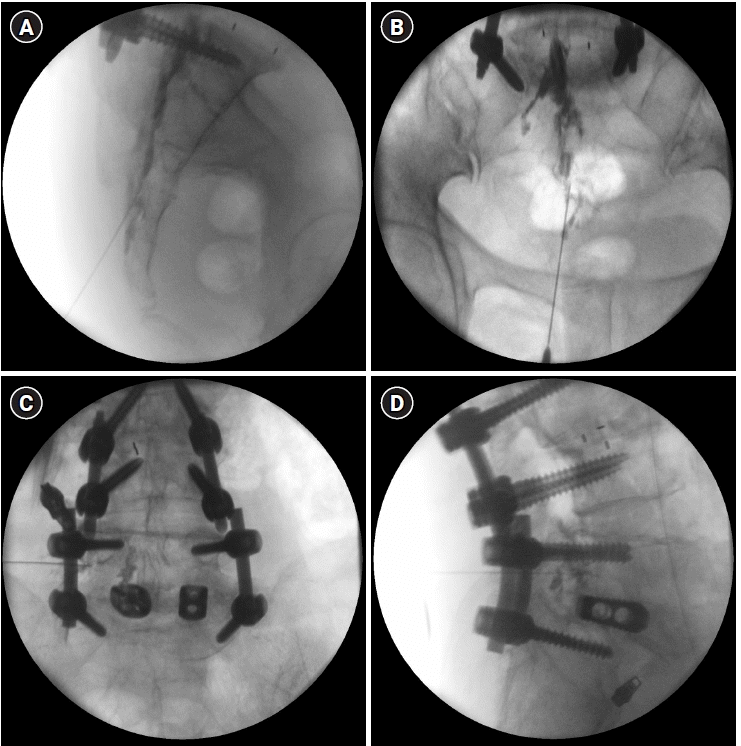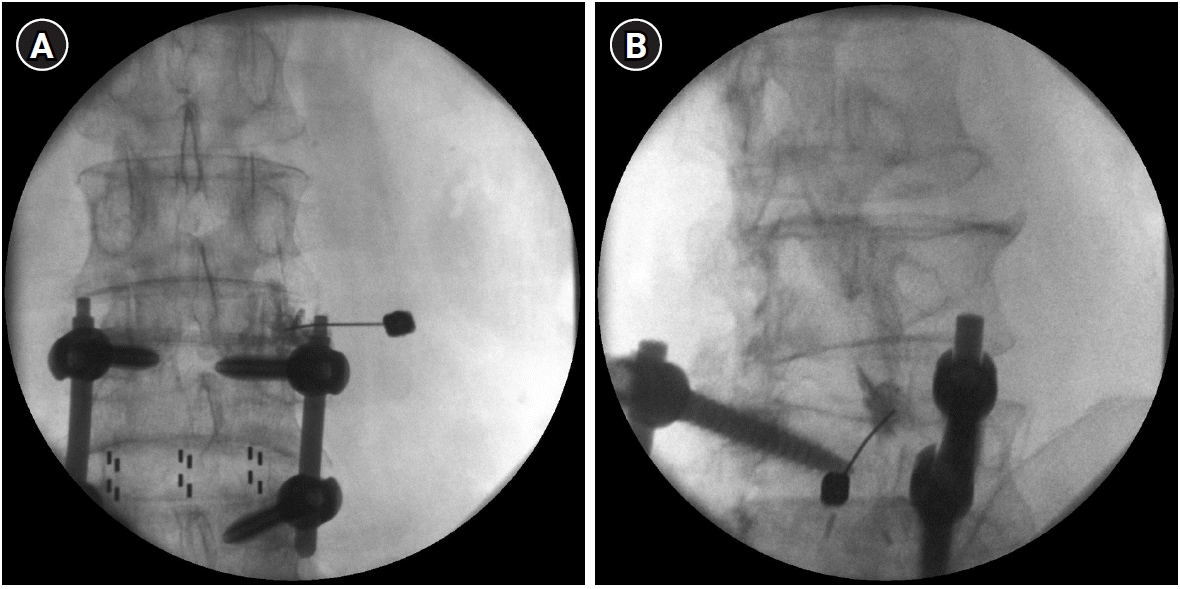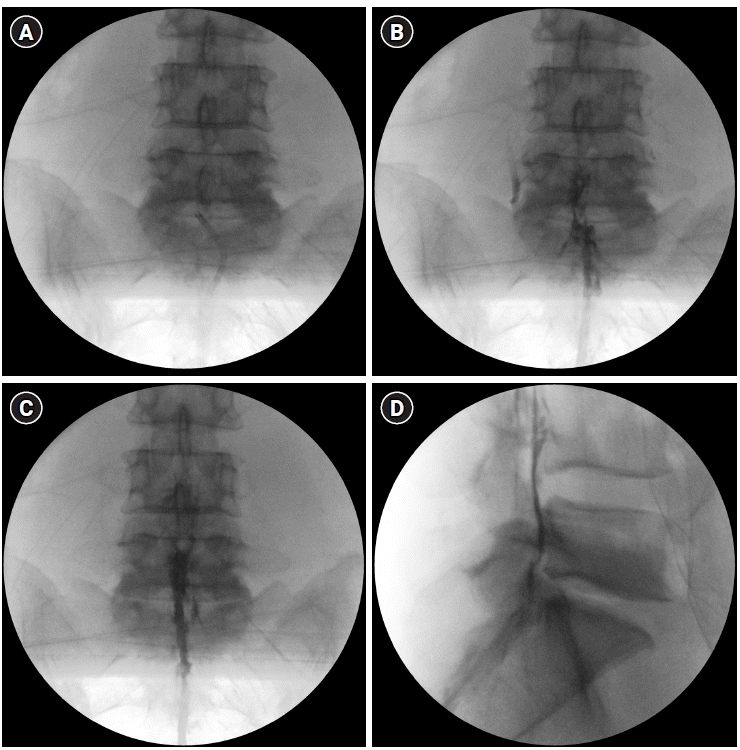1. Baber Z, Erdek MA. Failed back surgery syndrome: current perspectives. J Pain Res. 2016; 9:979–87.

2. Schofferman J, Reynolds J, Herzog R, Covington E, Dreyfuss P, O'Neill C. Failed back surgery: etiology and diagnostic evaluation. Spine J. 2003; 3:400–3.

3. Park YH, Choi EJ. Current strategy for chronic pain after spinal surgery. Anesth Pain Med. 2018; 13:363–71.

4. Deyo RA, Mirza SK, Martin BI, Kreuter W, Goodman DC, Jarvik JG. Trends, major medical complications, and charges associated with surgery for lumbar spinal stenosis in older adults. JAMA. 2010; 303:1259–65.

5. Carragee EJ, Alamin TF, Miller JL, Carragee JM. Discographic, MRI and psychosocial determinants of low back pain disability and remission: a prospective study in subjects with benign persistent back pain. Spine J. 2005; 5:24–35.

6. Celestin J, Edwards RR, Jamison RN. Pretreatment psychosocial variables as predictors of outcomes following lumbar surgery and spinal cord stimulation: a systematic review and literature synthesis. Pain Med. 2009; 10:639–53.

7. Mannion AF, Elfering A, Staerkle R, Junge A, Grob D, Dvorak J, et al. Predictors of multidimensional outcome after spinal surgery. Eur Spine J. 2007; 16:777–86.

8. Gum JL, Glassman SD, Carreon LY. Is type of compensation a predictor of outcome after lumbar fusion? Spine (Phila Pa 1976). 2013; 38:443–8.

9. Anderson JT, Haas AR, Percy R, Woods ST, Ahn UM, Ahn NU. Clinical depression is a strong predictor of poor lumbar fusion outcomes among workers' compensation subjects. Spine (Phila Pa 1976). 2015; 40:748–56.

10. Nguyen TH, Randolph DC, Talmage J, Succop P, Travis R. Long-term outcomes of lumbar fusion among workers' compensation subjects: a historical cohort study. Spine (Phila Pa 1976). 2011; 36:320–31.
11. Krueger JK, Rohrich RJ. Clearing the smoke: the scientific rationale for tobacco abstention with plastic surgery. Plast Reconstr Surg. 2001; 108:1063–77; discussion 1074-7.

12. Glassman SD, Anagnost SC, Parker A, Burke D, Johnson JR, Dimar JR. The effect of cigarette smoking and smoking cessation on spinal fusion. Spine (Phila Pa 1976). 2000; 25:2608–15.

13. Koenders N, Rushton A, Verra ML, Willems PC, Hoogeboom TJ, Staal JB. Pain and disability after first-time spinal fusion for lumbar degenerative disorders: a systematic review and meta-analysis. Eur Spine J. 2019; 28:696–709.

14. Evans L, O'Donohoe T, Morokoff A, Drummond K. The role of spinal surgery in the treatment of low back pain. Med J Aust. 2023; 218:40–5.

15. Smith ZA, Fessler RG. Paradigm changes in spine surgery: Evolution of minimally invasive techniques. Nat Rev Neurol. 2012; 8:443–50.

16. Harrod CC, Hilibrand AS, Fischer DJ, Skelly AC. Adjacent segment pathology following cervical motion-sparing procedures or devices compared with fusion surgery: a systematic review. Spine (Phila Pa 1976). 2012; 37(22 Suppl):S96–112.
17. Herzog RJ, Marcotte PJ. Assessment of spinal fusion. critical evaluation of imaging techniques. Spine (Phila Pa 1976). 1996; 21:1114–8.
18. Resnick DK, Watters WC, Sharan A, Mummaneni PV, Dailey AT, Wang JC, et al. Guideline update for the performance of fusion procedures for degenerative disease of the lumbar spine. Part 9: Lumbar fusion for stenosis with spondylolisthesis. J Neurosurg Spine. 2014; 21:54–61.

19. Rohde V, Mielke D, Ryang Y, Gilsbach JM. The immediately failed lumbar disc surgery: Incidence, aetiologies, imaging and management. Neurosurg Rev. 2015; 38:191–5.

20. North RB, Campbell JN, James CS, Conover-Walker MK, Wang H, Piantadosi S, et al. Failed back surgery syndrome: 5-year follow-up in 102 patients undergoing repeated operation. Neurosurgery. 1991; 28:685–91; discussion 690-1.

21. Rubio-Haro R, DE Andrés-Serrano C, Noriega González DC, Bordes-García C, DE Andrés J. Adjacent segment syndrome after failed back surgery: Biomechanics, diagnosis, and treatment. Minerva Anestesiol. 2022; 88:282–92.

22. Fransen P. Prevention of scar tissue formation in spinal surgery: State of the art and review of the literature. J Neurosurg Sci. 2011; 55:277–81.
23. Chan C, Peng P. Failed back surgery syndrome. Pain Med. 2011; 12:577–606.

24. Jamison DE, Hsu E, Cohen SP. Epidural adhesiolysis: an evidence-based review. J Neurosurg Sci. 2014; 58:65–76.
25. Low JCM, Von Niederhäusern B, Rutherford SA, King AT. Pilot study of perioperative accidental durotomy: does the period of postoperative bed rest reduce the incidence of complication? Br J Neurosurg. 2013; 27:800–2.

26. Rigoard P, Blond S, David R, Mertens P. Pathophysiological characterisation of back pain generators in failed back surgery syndrome (part B). Neurochirurgie. 2015; 61 Suppl 1:S35–44.

27. Rigoard P, Gatzinsky K, Deneuville J, Duyvendak W, Naiditch N, Van Buyten J, et al. Optimizing the management and outcomes of failed back surgery syndrome: a consensus statement on definition and outlines for patient assessment. Pain Res Manag. 2019; 2019:3126464.

28. Miękisiak G. Failed back surgery syndrome: no longer a surgeon's defeat-A narrative review. Medicina (Kaunas). 2023; 59:1255.

29. Kizilkilic O, Yalcin O, Sen O, Aydin MV, Yildirim T, Hurcan C. The role of standing flexion-extension radiographs for spondylolisthesis following single level disk surgery. Neurol Res. 2007; 29:540–3.

30. Weisenthal BW, Glassman SD, Mkorombindo T, Nelson L, Carreon LY. When does CT myelography add value beyond MRI for lumbar degenerative disease? Spine J. 2022; 22:787–92.

31. Patel DM, Weinberg BD, Hoch MJ. CT myelography: clinical indications and imaging findings. Radiographics. 2020; 40:470–84.

32. Corona-Cedillo R, Saavedra-Navarrete M, Espinoza-Garcia J, Mendoza-Aguilar A, Ternovoy SK, Roldan-Valadez E. Imaging assessment of the postoperative spine: an updated pictorial review of selected complications. Biomed Res Int. 2021; 2021:9940001.

33. Witkam RL, Buckens CF, Van Goethem JWM, Vissers KCP, Henssen DJHA. The current role and future directions of imaging in failed back surgery syndrome patients: an educational review. Insights Imaging. 2022; 13:117.

34. Rager O, Nkoulou R, Exquis N, Garibotto V, Tabouret-Viaud C, Zaidi H, et al. Whole-body SPECT/CT versus planar bone scan with targeted SPECT/CT for metastatic workup. Biomed Res Int. 2017; 2017:7039406.

35. Kato S, Demura S, Matsubara H, Inaki A, Shinmura K, Yokogawa N, et al. Utility of bone SPECT/CT to identify the primary cause of pain in elderly patients with degenerative lumbar spine disease. J Orthop Surg Res. 2019; 14:185.

36. Brusko GD, Perez-Roman RJ, Tapamo H, Burks SS, Serafini AN, Wang MY. Preoperative SPECT imaging as a tool for surgical planning in patients with axial neck and back pain. Neurosurg Focus. 2019; 47:E19.

37. Al-Zaghal A, Ayubcha C, Kothekar E, Alavi A. Clinical applications of positron emission tomography in the evaluation of spine and joint disorders. PET Clin. 2019; 14:61–9.

38. Follenfant E, Balamoutoff N, Lawson-Ayayi S, Dutronc H, Dupon M, Vital J, et al. Added value of [
18F]fluorodeoxyglucose positron emission tomography/computed tomography for the diagnosis of post-operative instrumented spine infection. Joint Bone Spine. 2019; 86:503–8.

39. Manchikanti L, Manchukonda R, Pampati V, Damron KS, McManus CD. Prevalence of facet joint pain in chronic low back pain in postsurgical patients by controlled comparative local anesthetic blocks. Arch Phys Med Rehabil. 2007; 88:449–55.

40. Thawrani DP, Agabegi SS, Asghar F. Diagnosing sacroiliac joint pain. J Am Acad Orthop Surg. 2019; 27:85–93.

41. Waguespack A, Schofferman J, Slosar P, Reynolds J. Etiology of long-term failures of lumbar spine surgery. Pain Med. 2002; 3:18–22.

42. Lee JH, Shin KH, Park SJ, Lee GJ, Lee CH, Kim DH, et al. Comparison of clinical efficacy between transforaminal and interlaminar epidural injections in lumbosacral disc herniation: a systematic review and meta-analysis. Pain Physician. 2018; 21:433–48.
43. Avellanal M, Diaz-Reganon G, Orts A, Soto S. One-year results of an algorithmic approach to managing failed back surgery syndrome. Pain Res Manag. 2014; 19:313–6.

44. Guner D, Asik I, Ozgencil GE, Peker E, Erden MI. The correlation of epidural fibrosis with epiduroscopic and radiologic imaging for chronic pain after back surgery. Pain Physician. 2021; 24:E1219–26.
45. Chou R, Huffman LH; American Pain Society; American College of Physicians. Medications for acute and chronic low back pain: a review of the evidence for an American Pain Society/American College of Physicians clinical practice guideline. Ann Intern Med. 2007; 147:505–14.

46. Malfliet A, Kregel J, Coppieters I, De Pauw R, Meeus M, Roussel N, et al. Effect of pain neuroscience education combined with cognition-targeted motor control training on chronic spinal pain: a randomized clinical trial. JAMA Neurol. 2018; 75:808–17.

47. Trager RJ, Daniels CJ, Meyer KW, Stout AC, Dusek JA. Clinical decision-making for spinal manipulation for persistent spinal pain following lumbar surgery: a protocol for a systematic review and meta-analysis of individual participant data. BMJ Open. 2021; 11:e054070.

48. Daniels CJ, Cupler ZA, Gliedt JA, Walters S, Schielke AL, Hinkeldey NA, et al. Manipulative and manual therapies in the management of patients with prior lumbar surgery: a systematic review. Complement Ther Clin Pract. 2021; 42:101261.

49. Kuijpers T, Van Middelkoop M, Rubinstein SM, Ostelo R, Verhagen A, Koes BW, et al. A systematic review on the effectiveness of pharmacological interventions for chronic non-specific low-back pain. Eur Spine J. 2011; 20:40–50.

50. Durand G, Girodon J, Debiais F. Medical management of failed back surgery syndrome in europe: evaluation modalities and treatment proposals. Neurochirurgie. 2015; 61 Suppl 1:S57–65.

51. Imamura T. Significant efficacy of tramadol/acetaminophen in elderly patients with chronic low back pain uncontrolled by NSAIDs: an observational study. Open Orthop J. 2015; 9:120–5.

52. Hussain A, Erdek M. Interventional pain management for failed back surgery syndrome. Pain Pract. 2014; 14:64–78.

53. Rao R, Panghate A, Chandanwale A, Sardar I, Ghosh M, Roy M, et al. Clinical comparative study: Efficacy and tolerability of tolperisone and thiocolchicoside in acute low back pain and spinal muscle spasticity. Asian Spine J. 2012; 6:115–22.

54. Gewandter JS, Frazer ME, Cai X, Chiodo VF, Rast SA, Dugan M, et al. Extended-release gabapentin for failed back surgery syndrome: results from a randomized double-blind cross-over study. Pain. 2019; 160:1029–36.

55. Sheldon BL, Olmsted ZT, Sabourin S, Heydari E, Harland TA, Pilitsis JG. Review of the treatments for central neuropathic pain. Brain Sci. 2022; 12:1727.

56. Ehde DM, Dillworth TM, Turner JA. Cognitive-behavioral therapy for individuals with chronic pain: efficacy, innovations, and directions for research. Am Psychol. 2014; 69:153–66.

57. Zgierska AE, Burzinski CA, Cox J, Kloke J, Singles J, Mirgain S, et al. Mindfulness meditation-based intervention is feasible, acceptable, and safe for chronic low back pain requiring long-term daily opioid therapy. J Altern Complement Med. 2016; 22:610–20.

58. Flor H, Fydrich T, Turk DC. Efficacy of multidisciplinary pain treatment centers: a meta-analytic review. Pain. 1992; 49:221–30.

59. Vowles KE, McEntee ML, Julnes PS, Frohe T, Ney JP, Van der Goes DN. Rates of opioid misuse, abuse, and addiction in chronic pain: a systematic review and data synthesis. Pain. 2015; 156:569–76.
60. Cohen SP, Raja SN. Pathogenesis, diagnosis, and treatment of lumbar zygapophysial (facet) joint pain. Anesthesiology. 2007; 106:591–614.

61. Schofferman J, Kine G. Effectiveness of repeated radiofrequency neurotomy for lumbar facet pain. Spine (Phila Pa 1976). 2004; 29:2471–3.

62. Kim SB, Lee KW, Lee JH, Kim MA, An BW. The effect of hyaluronidase in interlaminar lumbar epidural injection for failed back surgery syndrome. Ann Rehabil Med. 2012; 36:466–73.

63. Hossieni B, Dadkhah P, Moradi S, Hashemi SM, Safdari F. The results of treating failed back surgery syndrome by adhesiolysis: comparing the one- and three-day protocols. Anesth Pain Med. 2017; 7:e60271.

64. Manchikanti L, Singh V, Cash KA, Pampati V, Datta S. A comparative effectiveness evaluation of percutaneous adhesiolysis and epidural steroid injections in managing lumbar post surgery syndrome: a randomized, equivalence controlled trial. Pain Physician. 2009; 12:E355–68.
65. Hwang BY, Ko HS, Suh JH, Shin JW, Leem JG, Lee JH. Clinical experiences of performing transforaminal balloon adhesiolysis in patients with failed back surgery syndrome: two cases report. Korean J Anesthesiol. 2014; 66:169–72.

66. Manchikanti L, Pampati V, Bakhit CE, Pakanati RR. Non-endoscopic and endoscopic adhesiolysis in post-lumbar laminectomy syndrome: a one-year outcome study and cost effectiveness analysis. Pain Physician. 1999; 2:52–8.
67. Manchikanti L, Rivera JJ, Pampati V, Damron KS, Beyer CD, Brandon DE, et al. Spinal endoscopic adhesiolysis in the management of chronic low back pain: a preliminary report of a randomized, double-blind trial. Pain Physician. 2003; 6:259–67.
68. Kallewaard JW, Vanelderen P, Richardson J, Van Zundert J, Heavner J, Groen GJ. Epiduroscopy for patients with lumbosacral radicular pain. Pain Pract. 2014; 14:365–77.

69. Ceylan A, Aşık İ, Özgencil GE, Erken B. Evaluation of the efficacy of epiduroscopic adhesiolysis in failed back surgery syndrome. Turk J Med Sci. 2019; 49:249–57.

70. Geudeke MW, Krediet AC, Bilecen S, Huygen FJPM, Rijsdijk M. Effectiveness of epiduroscopy for patients with failed back surgery syndrome: a systematic review and meta-analysis. Pain Pract. 2021; 21:468–81.

71. Kumar K, Taylor RS, Jacques L, Eldabe S, Meglio M, Molet J, et al. Spinal cord stimulation versus conventional medical management for neuropathic pain: a multicentre randomised controlled trial in patients with failed back surgery syndrome. Pain. 2007; 132:179–88.

72. Caraway D, Walker V, Becker L, Hinnenthal J. Successful discontinuation of systemic opioids after implantation of an intrathecal drug delivery system. Neuromodulation. 2015; 18:508–15. ; discussion 515-6.

73. Arts MP, Kols NI, Onderwater SM, Peul WC. Clinical outcome of instrumented fusion for the treatment of failed back surgery syndrome: a case series of 100 patients. Acta Neurochir (Wien). 2012; 154:1213–7.








 PDF
PDF Citation
Citation Print
Print



 XML Download
XML Download